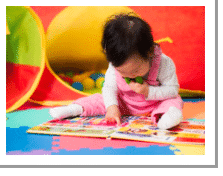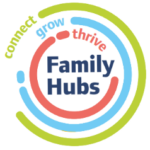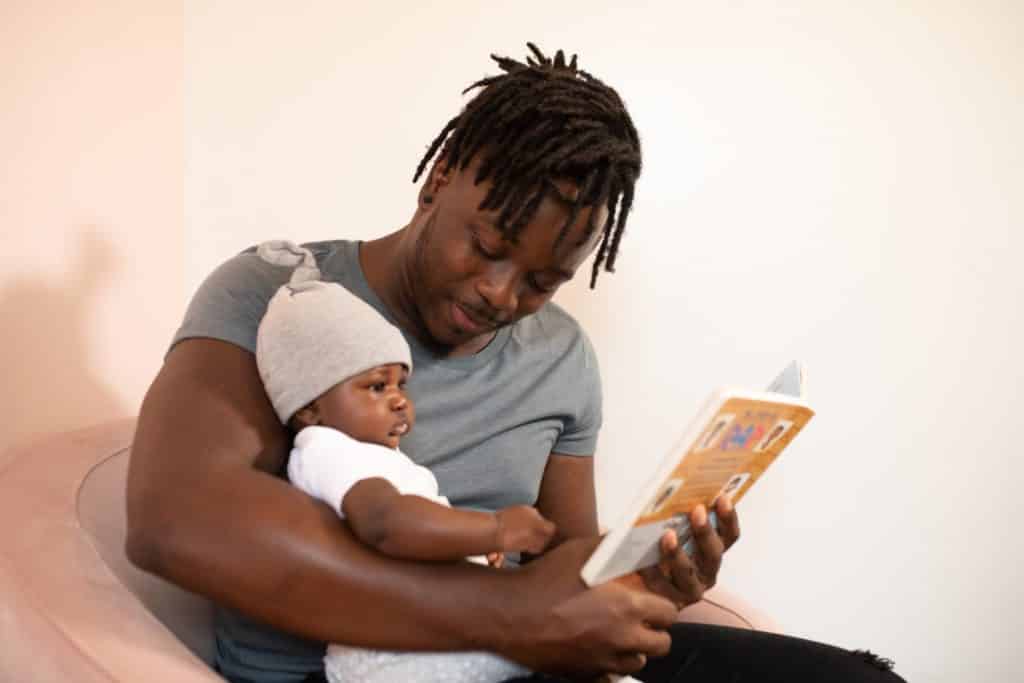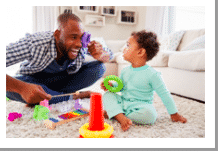
My name is Anne I am an Early Years Practitioner and trained Henry Facilitator. I run the Little Explorers sessions and for the last couple of weeks we have been using Five to Thrive, looking at how your baby’s brain grows better, when you do five simple things that feed the brain RESPOND, CUDDLE, RELAX, PLAY, and TALK
Communicating With Your Baby
You might feel silly talking to your baby, as they don’t answer or understand you. Or, do they?
Your baby’s first year will be full of changes From the first smiles, gurgles, and coos to learning to say “mama” or “dada,” babies love to communicate with their own form of baby talk. And they hope you’ll “baby talk” right back.
All through this first year, you can do a lot to encourage your baby’s communication skills, it’s easy. All you need do is smile, talk, sing, and read to your baby.
Why focus on communicating with your baby? Because early speech and language skills are associated with success in developing reading, writing, and interpersonal skills, both later in childhood and later in life.
Baby Talk: Smile and Pay Attention
Long before they can speak clearly, babies understand the general meaning of what you’re saying. They also absorb emotional tone. Encourage baby’s early attempts to communicate with you with loving attention:
- Smile often at your baby, especially when he is cooing, gurgling, or otherwise vocalising with baby talk.
- Look at your baby as he or she babbles and laughs, rather than looking away, interrupting, or talking with someone else.
- Be patient as you try to decode your infant’s baby talk and nonverbal communication, like facial expressions, gurgling, or babbling sounds that could signal either frustration or joy.
- Make time to give your baby lots of loving attention, so the can “speak” to you with their baby talk, even when you’re busy with other tasks.

Right from the start, baby talk should be a two-way street. By imitating your baby, you’ll send an important message: what they may be feeling and trying to communicate matters to you.
- Have back-and-forth conversations in baby talk to teach your baby the give-and-take of adult conversation.
- Imitate baby’s vocalizations — “ba-ba” or “goo-goo” — then wait for him or her to make another sound, and repeat that back.
- Do your best to respond, even when you don’t understand what your baby is trying to say.
- Reinforce communication by smiling and mirroring facial expressions.
- Because gestures are a way babies try to communicate, imitate your baby’s gestures, as well.
Baby Talk: Talk Often to Your Baby
Babies love to hear you talk especially to them, and especially in a warm, happy voice. Babies learn to speak by imitating the sounds they hear around them. So the more you talk to your baby, the faster they will acquire speech and language skills.
- Many adults use a special tone of voice when talking baby talk a high-pitched voice with exaggerated expression. This natural baby talk mimics the female voice, which babies the world over associate with feeding and comfort.
- Keep in mind that talking “baby talk” won’t prevent or delay your baby from learning adult speech later.
- Engage your baby’s listening skills by talking often to them throughout the day, narrating your activities together. Talk as you are feeding, dressing, carrying, and bathing your baby, so he or she begins to associate these sounds of language with everyday objects and activities.
- Repeat simple words like “mama” and “bottle” often and clearly so your baby begins to hear familiar words and associate them with their meaning.
Baby Talk: How Babies Learn to Talk
Parents often wonder where their child’s speech ability is on the learning curve. The timeline for each child varies greatly: Some babies can say a few words at 12 months, but others may not talk until they’re 18 months old and then talk short sentences.
- At 1 to 3 months: Babies already love to hear the sound of your voice and may smile, laugh, get quiet, or get excited and wave their arms when you talk or sing to them. Your baby talk usually starts with cooing and gurgling, with some vowel sounds, like “ooh,” appearing at around two months.

- At 4 to 7 months: Babies now realize that their baby talk has an impact on their parents. They babble more and watch for their parents’ reaction. Babies experiment with more sounds and intonations. They begin to raise and lower the pitch of their voices as they babble, just as adults do when asking a question or adding emphasis.
Baby Talk: Communicating With Your Baby
As you introduce your baby to simple, short words like “cup” and “ball,” hold up the object to show that it’s related to your speech. Read colourful picture books to your baby. Point to the pictures, and name simple objects to reinforce their early speech development and model the importance of language and reading. Practice using short words and then pausing. This will allow your baby to respond with their own baby talk and encourage the give-and-take interaction that’s needed for adult conversation.
- At 8 to 12 months: It’s a unique joy for parents to hear their baby say “mama” or “dada” for the first time. But the first few times may actually be accidental. Baby talk at this age is still primarily a hit-or-miss playing with sounds like “ga-ga,” “da-da,” and “ba-ba.”
Smile, face your baby, and continue to repeat simple words clearly throughout the day. This will help your baby’s growing brain to store the sounds and meanings of words for everyday objects. At this age, babies love one-on-one interaction with you. They also love games and songs with language, like “Itsy Bitsy Spider” and “Patty-Cake.”

During the first year, baby should respond to your baby talk by cooing, gurgling, and beginning to babble back. He should respond to “no,” to his or her own name, and to simple requests like “come here.
So while normal language development has wide variation, it’s better to be safe than sorry when it comes to your child’s growth. Have your baby’s speech evaluated at each well-baby check-up, and talk with your baby’s doctor if you’re concerned about delayed speech or a hearing problem. And remember: Your baby loves to hear your voice, so don’t be embarrassed by your own “silly” baby talk.




